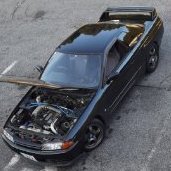Sydneykid Your A Legend
Announcements
-
Similar Content
-
Latest Posts
-
By Dose Pipe Sutututu · Posted
Fark what are the changes of that snapping like that, clean. Nek minnit, custom radiator goes in, with built in oil cooler like those discontinued PWR ones from yesterdeacades ago -
I thought I'd do a write up on an auto transmission fluid change for a the nissan 7 speed Automatic. At some stage the genius engineers decided that the fluid in the trans was "for the life of the transmission", (which seems kind of self supporting to me) and removed the dip stick and fill tube (funnily enough there is still a casting for it). Anyway, for this job you do need 2 specialist tools in addition to regular hand tools, jack and good chassis stands. You need a way to pump fluid up to the transmission; I got one of these but there are plenty of other options: https://www.ebay.com.au/itm/364584087070 Don't trust the generic listing though, it does not come with the required adapter for the Nissan 7 Speed. You need one of these, can't do the job without it: https://navarapart.com.au/product/genuine-nissan-patrol-y62-d23-np300-navara-re7-dipstick-fill-connector1 You need a heap of compatible transmission oil. Could be Nissan, could be anything else rated for Nissan Matic S. You need at least 10 litres, I had 15 to give it a better flush... Also, you need some biiig oil catch trays, at least one of these, or bigger if possible (volume was fine, size was very marginal): https://autobarn.com.au/ab/Autobarn-Category/Tools-%26-Garage/Specialty-Tools/Oil-Service/Garage-Tough-Oil-Drain-Pan-Black-16L---GT1068/p/TO03191 Finally, a measuring jug is very useful if your pump does not have volumes marked on it, I got a 6l one: https://www.repco.com.au/oils-fluids/fluid-accessories/measuring-jugs/penrite-measuring-jug-6l-pmj006/p/A5322648 Oh, and gloves.....this stuff is horrible (not as bad as diff oil, but getting there) ....First, jack up your car.....
-
So I mentioned the apprentice, @LachyK helped take the bonnet off. We just undid the nuts on the hinges and unclipped the gas struts, then pulled the bonnet back a little as the front was catching on the front bar. I had a good look at everything today and have removed the rams, repaired/reset the hinges and bolted it back together like it never happened. I'll do a separate write up on the repair, and I also removed the poppers from the Fuga today too to save grief down the road.....as said above it is at least $5k to repair retail. I'm also happier about my ability to prepare a race car, and less happy about Nis-nault's engineering (I can hear @GTSBoy sAfrican Americaning) because the top hose of the radiator didn't slip off.......it snapped clean off. By practice I put the hose clamp hard up against the flare on a neck to make it least likely to ever move (thanks @Neil!). I guess that puts a little more pressure on the end of the pipe as it is further away from the rad, but still, that is pretty shit. I've put it back on for now as there was a fair bit of neck still there, but obviously there is no lip on the neck any more so I don't think I'll track it again until I have a new rad. Speaking of which....more research required. It looks like Koyo makes a standard size radiator in ally which I'll grab in the meantime, but I really want something thicker so might have to go custom in the medium term (ouch) Coolant still needs a refill and I have the pressure tester on it over night, but other than a wash down of the engine bay it seems alright. And @MBS206 noted something noisy on the front of the engine and I think I agree....time for a new accessory belt and tensioners I think.
-
our good friends at nismo make a diff for it, I have one (and a spare housing to put the centre in) on the way. https://www.nismo.co.jp/products/web_catalogue/lsd/mechanical_lsd_v37.html AMS also make a helical one, but I prefer mechanical for track use in 2wd (I do run a quaife in the front, but not rear of the R32)
-
What are we supposed to be seeing in the photo of the steering angle sensor? The outer housing doesn't turn, right? All the action is on the inside. The real test here is whether or not your car has had the steering put back together by a butcher. When the steering is centred (and we're not caring about the wheel too much here, we're talking about the front wheels, parallel, facing front) then you should have an absolutely even number of turns from centre to left lock and centre to right lock. If there is any difference at all then perhaps the thing has been put back together wrongly, either the steering wheel put on one spline (or more!) off, and the alignment bodged to straighteb the wheel, or the opposite where something silly was done underneath and the wheel put back on crooked to compensate. Nut there isn't actually much evidence that you have such a problem anyway. It is something you can easily measure and test for to find out though. My money is still on the HICAS CU not driving the PS solenoid with the proper PWM signal required to lighten the load at lower speed. If it were me, I would be putting either a multimeter or oscilloscope onto the solenoid terminals and taking it for a drive, looking for the voltage to change. The PWM signal is 0v, 12V, 0V, 12v with ...obviously...modulated pulse width. You should see that as an average voltage somewhere between 0V and 12V, and it should vary with speed. An handheld oscilloscope would be the better tool for this, because they are definitely good enough but there's no telling if any cheap shit multimeter that people have lying around are good enough. You can also directly interfere with the solenoid. If you wire up a little voltage divider with variable resistor on it, and hook the PS solenoid direct to 12V through that, you can manually adjust the voltage to the solenoid and you should be able to make it go ligheter and heavier. If you cannot, then the problem is either the solenoid itself dead, or your description of the steering being "tight" (which I have just been assuming you mean "heavy") could be that you have a mechanical problem in the steering and there is heaps of resistance to movement.
-







Recommended Posts
Create an account or sign in to comment
You need to be a member in order to leave a comment
Create an account
Sign up for a new account in our community. It's easy!
Register a new accountSign in
Already have an account? Sign in here.
Sign In Now